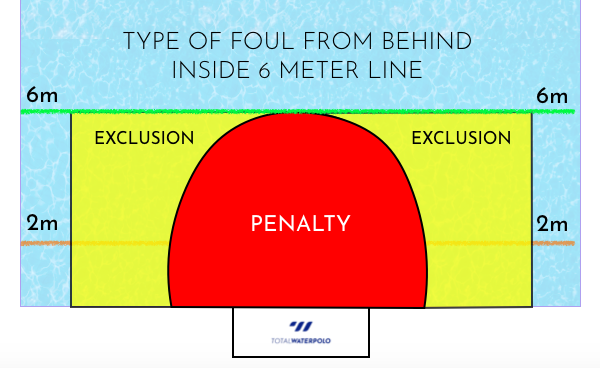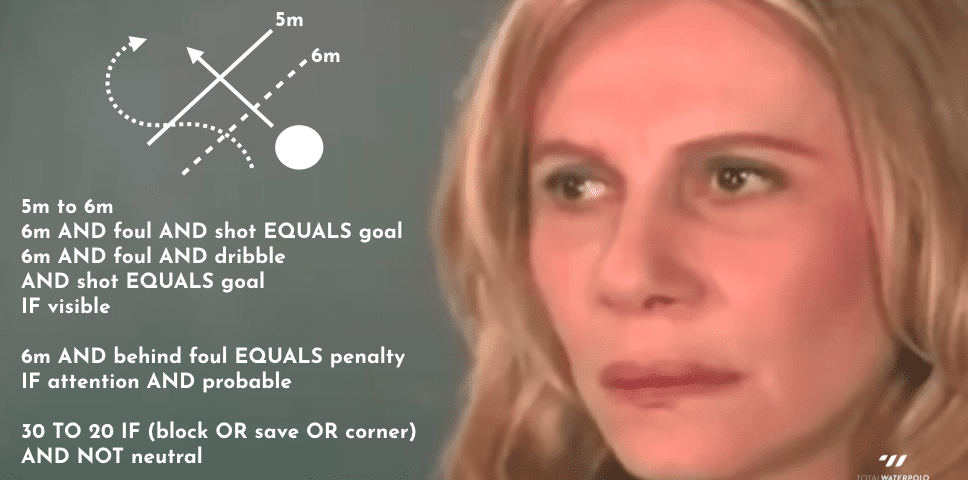After a lot of consultations, we think we finally got all the new water polo rules sorted out. Most of them are quite simple, but it is important to take into consideration some ongoing rules.
How can you score from a free throw awarded outside of 6 meters?
The first important thing about this rule is that when the foul is whistled, both foul and the ball must be on or outside the 6-meter line. If you are not sure whether you are in the right position to score, the referee will give a sign by raising his hand to confirm that you are in a shooting position to score from the free throw.
In that case, you have an option to shoot directly or to continue the play by putting the ball into action. As FINA’s Water polo Technical Committee explained, this means that the ball needs to leave the hand. You don’t need to throw it in the air, you can pick it up and drop it on the water, but the detaching needs to be visible. Even switching the ball from one hand to the other on the water surface means you continued the play and that the defender can attack you. After putting the ball back into play, you can fake, swim or shot.
If the referee asks for the ball because of cap replacement, injury or some other issue, you can’t shot directly anymore, but you can put the ball in play and proceed as previously mentioned.
The first video is an example of how to apply this rule. The second one is a good negative example of not putting the ball obviously (visibly) enough into play – the goal was disallowed.
Free throw SHALL be taken from the position of the ball
The game continues from the ball position, not from the position of the foul. The only exception applies when the ball is inside the 2-meter line during the foul call. The following free throw needs to be taken from the 2m-line.
Keep in mind that you are not allowed to score a goal if the ball was inside the 6-meter mark, even if you were fouled outside of 6 meters. So for example, the defender made a foul on you on 6.5 meters, while the ball floats to 5 meters – in this case, you can not take the ball and go back outside the 6-meter line and shoot.
When does the shot clock reset to 20 seconds?
This one is quite simple. Every time you get a second possession (corner, exclusion, missed a penalty, missed shot) the shot clock reset to 20 seconds if you had less than 20 seconds on the shot clock when the possession is gained. If you had, for example, 23 seconds left, the time will continue to run from there and not reset.
NOTICE – the clock will reset to 30 seconds only in case of a neutral throw or if the coach decides to choose possession instead of penalty in the last minute game situation (when the opposing team deliberately wants to commit a penalty foul to regain possession quickly).
Is every foul from behind committed against the player with the ball facing the goal inside the 6-meter line a penalty?
Yes and no… This one will surely need some more discussion and analysis. FINA’s Water polo Technical Committee explained you need to be in a probable goal position and have the intention to score. So if you are not alone in the counter-attack, this picture below shows the area of probable goal position in which the rule should be applied.

The only way to defend this is to have contact with the ball (so no arm nor hand!). When attacking, we recommend you to act as nobody is behind you, keep the ball in front and try to score a goal. One important thing you need to be aware of is that referees are guided to wait for the call, so even if you get fouled and they see that you still in the situation to score, they will let you finish the action. But if you miss you won’t get a penalty, and if you score the defender won’t get an exclusion.
IMPORTANT VIDEO – Many of you probably thought that this situation on Pjetlović is a clear application of new rules, but actually, this was a mistake. This wasn’t a penalty because the defender (Filipović blocking the shot) was in between the attacker and goal. In fact, this isn’t even a foul, because the ball was in the hand. Once again, to apply this rule, you need to be in a probable goal situation with attention to score a goal. Having a defender in front of you is not treated as a probable position.
A goalkeeper can join the offense and play at any time
An exciting rule you can use if you have the last possession at the end of the period. We already had some examples where this rule created an advantage for the attacking team.
Flying substitutions
You can make flying substitutions in the outline area between your goal line and halfcourt mark. Excluded players still need to use the re-entry box. You can make as many subs as you want. When you leave the pitch your head must be above the water and you need to clap hands with player who is coming in.
Other new rules
Shorter halftime break (from 5 to 3 minutes)
Two timeouts per game instead of one per period
Video technology during the game to determine (only) goal-line decisions
Video technology to determine unpunished brutality fouls after the game
All the rules are still new and surely there will be more confusing situations, but we encourage you to communicate with referees and delegates (before or after the game 🙂 ). With open communication, everyone will benefit and we can get a standard criterium in the whole water polo community. This is a learning process for everybody.
If you have any videos of examples or unclear situations, please send them to our email info@total-waterpolo.com or share it with us on our social media channels – Facebook, Instagram or Twitter.






